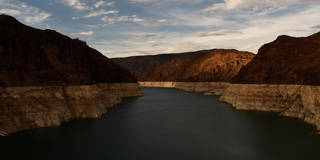Farmers in the western United States argue that without access to relatively affordable water for cultivating feed-related crops such as alfalfa, the cost of beef and dairy products would increase. But why should the American public subsidize the production of beef and dairy products or the cultivation of rice in a desert?
CAMBRIDGE – A megadrought – the worst in 1,200 years – has been ravaging the American West for two decades, fueling wildfires and exacerbating the region’s chronic water shortages. As global temperatures continue to rise, severe droughts are becoming more frequent and intense – a trend not limited to the United States. Southern Europe, East and North Africa, Australia, and certain parts of Asia and Latin America are also grappling with extreme water scarcity.
On May 22, seven western US states reached a historic deal to reduce water extraction from the drought-stricken Colorado River. Arizona, California, and Nevada have committed to a 14% reduction in their consumption from the Colorado River Basin, a vital water source for roughly 40 million people, by 2026.
Even when economists strongly believe they have a solution to a problem, their proposals are often neglected in policy deliberations. Water scarcity is a prime example. Introductory economics textbooks explain that when public policy keeps the price of a resource artificially below its fundamental value, the result is high demand, low supply, and inevitable shortages. Hence, economists advocate raising the price of water through market pricing.

CAMBRIDGE – A megadrought – the worst in 1,200 years – has been ravaging the American West for two decades, fueling wildfires and exacerbating the region’s chronic water shortages. As global temperatures continue to rise, severe droughts are becoming more frequent and intense – a trend not limited to the United States. Southern Europe, East and North Africa, Australia, and certain parts of Asia and Latin America are also grappling with extreme water scarcity.
On May 22, seven western US states reached a historic deal to reduce water extraction from the drought-stricken Colorado River. Arizona, California, and Nevada have committed to a 14% reduction in their consumption from the Colorado River Basin, a vital water source for roughly 40 million people, by 2026.
Even when economists strongly believe they have a solution to a problem, their proposals are often neglected in policy deliberations. Water scarcity is a prime example. Introductory economics textbooks explain that when public policy keeps the price of a resource artificially below its fundamental value, the result is high demand, low supply, and inevitable shortages. Hence, economists advocate raising the price of water through market pricing.